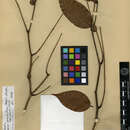Comprehensive Description
provided by Smithsonian Contributions to Botany
Eperua grandiflora (Aublet) Bentham guyanensis Cowan
A ssp. grandiflora foliola marginibus revolutis minute venulosis, antheris aliquando leviter minuteque puberulis, ovario gynophoroque dense pilosuloso differt.
TYPE COLLECTION.—T. G. Tutin 245 (holotype US sheet 1743474, isotypes BM, K, U), 83 mi Bartica-Potaro Road, Guyana, 23 June 1933.
DISTRIBUTION.—Central to south-central Guyana in low forest on white sands.
GUYANA: Along Berbice-Rupununi Cattle Trail, Berbice or Demerara County, 20 May 1919, Abraham 133 (K, NY); Essequibo-Mazaruni Divide, 0.5 m S of Bartica, 2 Sept 1932, Davis 317 (FD 2310) (K) and 318 (FD 2311) (K); upper Rupununi R., near Dadanawa, 24–29 July 1922, de la Cruz 1704 (GH, NY, US); Moraballi Creek, 11 Nov 1940, Fanshawe 605 (FD 3341) (K, NY); branch of Eberoabo R., Berbice Co., 20 May 1919, Hohenkerk 788 (K); Essequibo R., opposite Bartica, Nov 1886, Jenman 2482 (K, NY); no precise locality or date, Jenman 6269 (K, NY); Great Falls, Demerara R., March 1898, Jenman 7304 (K); Essequibo R., Moraballi Creek, near Bartica, 20 Sept 1929, Sandwith 314 (K, NY, RB, U); no locality, 1844, Rich. Schomburgk 988 (1722) (BM, G, GH, K, P, W).
LOCAL NAMES AND USES.—Ituri wallaba (Sandwith 314); yoboko wallaba (Hokenkerk 788). Used for firewood.
- bibliographic citation
- Cowan, Richard S. 1975. "A Monograph of the Genus Eperua (Leguminosae: Caesalpinioideae)." Smithsonian Contributions to Botany. 1-45. https://doi.org/10.5479/si.0081024X.28
Comprehensive Description
provided by Smithsonian Contributions to Botany
Eperua grandiflora (Aublet) Bentham
Eperua grandiflora (Aublet) Bentham, Fl. Bras. 15(2):226, 1870.
Tree 8–30 m tall, the trunk 20–40 cm in diameter, the branchlets glabrous, nitid; stipules deciduous to persistent, more or less foliaceous, rigid, glabrous, falcate-lanceolate or falcate-elliptic, or inequilaterally oval to elliptic to lanceolate, sometimes lanceolate-triangular, 4–12 mm long, 2–7 mm wide; leaves glabrous or sometimes micropuberulous on the upper surface of the base of the costa and leaflet blade, the petioles 9–21 mm long, the rachis 4.5–12.5 cm long; leaflets 3- or 4-jugate, the petiolules 4–8 mm long, the blades epunctate, rigid-coriaceous, nitid, plane or marginally revolute, all elliptic to lanceolate or frequently the lowermost pair ovate to lanceolate, (4−)7–11.5 (−15) cm long, 2–5 (−7.3) cm wide, the base of the lowest pair or of all but the terminal pair rounded-obtuse, the others acute to attenuate-acute, the apex acute to long-acuminate, mucronulate, the venation prominulous to subobscure; inflorescences axillary racemes of racemes 3–10 cm long, the axes minutely puberulous, the bracts broadly ovate, 2–4 mm long, 3–4 mm wide, ciliolate, minutely puberulous externally, the bracteoles 3–4 mm long, 3–5 mm wide, broadly ovate, imbricate, clasping the upper part of the pedicel and the hypanthium base, pubescent as the bracts, arising at or near the pedicel-apex, usually at slightly different levels; pedicels 4–5.5 mm long, minutely puberulous, the hypanthium inequilaterally cupular, 11.5 mm long, 2.5–4 mm in diameter, minutely puberulous externally, the nectaries projecting above the hypanthial rim; sepals oblong to elliptic, 10–12.5 mm long, 2–6 mm wide, minutely puberulous externally, the dorsal one concave and larger; petal pale pink or lavender-pink, more or less flabelliform, 2.5–3.5 cm long, 2.5–4.5 cm wide, glabrous, the petalodia 0.8–2 mm long, 0.4–0.8 mm wide; 4 or 5 of stamens with larger anthers, the filaments of 9 united in an inequilateral tube 3–5 mm long on the shorter side, 5–6.5 mm on the longer, the filaments 15–30 mm long, puberulous in the united region but mostly glabrous above, the anthers oval, 1.8–2.5 mm long, 1–1.5 mm wide, more or less puberulous or glabrous; stigma obtuse, the style 19–28 mm long, the ovary obovate, 3–5 mm long, 1.5–3 mm wide, densely pilosulose or glabrous, the gynophore 3–5 mm long, pilosulose or glabrous; fruits not seen.
- bibliographic citation
- Cowan, Richard S. 1975. "A Monograph of the Genus Eperua (Leguminosae: Caesalpinioideae)." Smithsonian Contributions to Botany. 1-45. https://doi.org/10.5479/si.0081024X.28
Comprehensive Description
provided by Smithsonian Contributions to Botany
Eperua grandiflora (Aublet) Bentham ssp. grandiflora
Parivoa grandiflora Aublet, Pl. Guian. 2:756, pl. 303, 1775.
Dimorpha grandiflora (Aublet) Willdenow, Sp. Pl. 3(2):971, 1–10 Nov 1802.
Eperua kourouensis Benoist in Lecomte, Not. Syst. 3:273, 7 May 1917.
Leaflets plane; anthers and gynoecium glabrous.
TYPE COLLECTION.—F. Aublet s.n. (holotype BM) “ad ripas fluviorum Guianae,” French Guiana.
DISTRIBUTION.—Frequent in forest along Rio Araguarí on Brazil-French Guiana Border, coastal French Guiana and south-central Suriname.
SURINAME: Upper Coppename R., Oct 1901, Boon 1209 (U); Fallawatra, 18 Jan 1972, Jimenez-Saa 1698 (K). FRENCH GUIANA: Gourdonville, Kourou R., 8 Sept 1914, Benoist 1595 (P) (type of E. kourouensis Benoist). BRAZIL. Terr. Amapá, Rio Araguarí : 2 Sept 1961, Pires et al 50673 (F, NY, R, U, US), 12 Sept 1961, Pires et al 50878 (GH, NY, RB, U, US), 29 Sept 1961, Pires et al 51307 (G, NY, U, US); vicinity of Piedra Fina, 10 Oct 1961, Pires 51659 (F, GH, K, NY, U, US).
- bibliographic citation
- Cowan, Richard S. 1975. "A Monograph of the Genus Eperua (Leguminosae: Caesalpinioideae)." Smithsonian Contributions to Botany. 1-45. https://doi.org/10.5479/si.0081024X.28
Eperua grandiflora
provided by wikipedia EN
Eperua grandiflora (Arawak: Yoboko, Itoeri Walaba, Guyanese Creole: Ituri Wallaba, Yokobo Wallaba)[2] is a species of flowering plant in the family Fabaceae, native to northern South America.[1][3] This evergreen tree is used both for construction and medicinal purposes. Its inner bark is decoted as a traditional remedy for toothache.[2] This tree relies on gravity to disperse its seeds.[4]
References

- license
- cc-by-sa-3.0
- copyright
- Wikipedia authors and editors
Eperua grandiflora: Brief Summary
provided by wikipedia EN
Eperua grandiflora (Arawak: Yoboko, Itoeri Walaba, Guyanese Creole: Ituri Wallaba, Yokobo Wallaba) is a species of flowering plant in the family Fabaceae, native to northern South America. This evergreen tree is used both for construction and medicinal purposes. Its inner bark is decoted as a traditional remedy for toothache. This tree relies on gravity to disperse its seeds.
- license
- cc-by-sa-3.0
- copyright
- Wikipedia authors and editors

